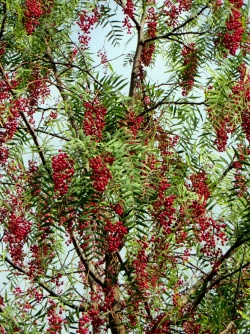Pink pepper
From Wikiwel
Other Names: Schinus Molle , Pink peppercorn, baies roses, poivre rosé, faux poivre, California Pepper, peppertree, pepper tree berry oil. The Schinus Molle is a very versatile plant. Cultures from around the world use the bark, leaves and berries from the plant in their teas and poultices.
Special Precautions of Pink pepper
- Warning : Essential Oil contains myrcene, which is known to cause cancer
- Avoid if you have low blood pressure
- Avoid during pregnancy
Benefits and uses of Pink pepper are
Throughout South and Central America, Brazilian peppertree is reported to be an astringent, antibacterial, diuretic, digestive stimulant, tonic, antiviral and wound healer.
- As a broad-spectrum antimicrobial and antiseptic against bacterial, viral and fungal infections. The essential oil has proved as an effective antibacterial medicine in vitro and have a anti-microbial activity against many bacteria and pathogens in several studies. Testing in vitro, the molle essential oil from the leaves, showed antiviral effects against several viruses
- For Candida and yeast infections
- To tone, balance and strengthen heart function and as a heart regulator for arrhythmia and mild hypertension
- antidepressant effects
- Treating a variety of wounds and infections due to its antibacterial and antiseptic properties
- To stop bleeding and heal wounds internally and externally
- For mycoplasmal infections
- Cancer : proved to be cytotoxic against cancer cells 9kb.
- In Peru The sap is used as a mild laxative and a diuretic, and the entire plant is used externally for fractures and as a topical antiseptic. The oleoresin is used externally as a wound healer, to stop bleeding, and for toothaches, and it is taken internally for rheumatism and as a purgative.
- In South Africa, a leaf tea is used to treat colds, and a leaf decoction is inhaled for colds, hypertension, depression and irregular heart beat.
- In the Brazilian Amazon, a bark tea is used as a laxative, and a bark-and-leaf tea is used as a stimulant and antidepressant. In Brazilian herbal medicine today, the dried bark and/or leaves are employed for heart problems (hypertension and irregular heart beat), infections of all sorts, menstrual disorders with excessive bleeding, tumors and general inflammation. A liquid extract or tincture prepared with the bark is used internally as a stimulant, tonic and astringent, and externally for rheumatism, gout, and syphilis.
- In Argentina, a decoction is made with the dried leaves and is taken for menstrual disorders, and is also used for respiratory and urinary tract infections and disorders.
- It is used for many conditions in the tropics, including menstrual disorders, bronchitis, gingivitis, gonorrhea, gout, eye infections, rheumatism, sores, swellings, tuberculosis, ulcers, urethritis, urogenital disorders, venereal diseases, warts, and wounds.
References
- Ferreroa, Adriana; Alejandra, Minettib; Cristina, Brasa; Zanettia, Noelia (2007), "Acute and subacute toxicity evaluation of ethanolic extract from fruits of Schinus molle in rats", Journal of Ethnopharmacology (2007-09-25) 113 (3), pp. 441–447, doi:10.1016/j.jep.2007.06.019, PMID 17716846
- Machadoa, Daniele G.; Kastera, Manuella P.; Binfaréa, Ricardo W.; Diasc, Munique; Santosb, Adair R.S.; Pizzolattic, Moacir G.; Brighentec, Inês M.C.; Rodrigues, Ana Lúcia S. (2007), "Antidepressant-like effect of the extract from leaves of Schinus molle L. in mice: Evidence for the involvement of the monoaminergic system", Progress in Neuro-Psychopharmacology and Biological Psychiatry (Elsevier, published 2007-03-30) 31 (2): 421–428, doi:10.1016/j.pnpbp.2006.11.004, PMID 17182164
- Daniele G. Machado, Luis E.B. Bettio, Mauricio P. Cunha, Adair R.S. Santos, Moacir G. Pizzolatti, Inês M.C. Brighente, and Ana Lúcia S. Rodrigues (2008). "Antidepressant-like effect of rutin isolated from the ethanolic extract from Schinus molle L. in mice: Evidence for the involvement of the serotonergic and noradrenergic systems." Eur. J' Pharmacol. 587 163-168.
